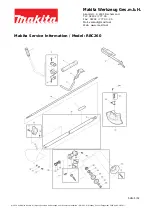
UTA-151 User Manual
© Camrivox Ltd. 2006
Page 8 of 20
3.3. Failsafe
mode
In some situations it is not possible to make VoIP calls, for example, if your Internet
connection goes down, or if there is a power cut. In such situations your UTA-151 will enter a
failsafe mode. The purpose of this mode is to enable your telephone to make phone calls,
albeit over your land line rather than VoIP, even in the event of problems.
If ever failsafe mode is entered you will hear a recorded diagnostic message describing the
problem (except in the power failure case). This should help you to resolve the problem. See
section 6.3 for more information on these diagnostic messages.
3.4. Advanced Telephone Functions
One of the advantages of VoIP is that it offers advanced telephony functions such as:
•
Putting a call on hold.
•
Call waiting
•
Making two simultaneous calls.
•
Transferring calls.
•
Do not disturb.
•
Call return.
3.4.1. Recall / Hook-flash
To access certain VoIP functions it is necessary to perform a Recall or Hook-flash. The
majority of phones have a dedicated button for this purpose. The button is often labelled
“Recall” or sometimes just “R” (note: not to be confused with Redial which is a different
button to Recall).
For phones that do not have a Recall button it is possible to simulate it by doing what is
known as a “Hook-flash”. As its name suggests a Hook-flash is performed by briefly tapping
the button that is pressed when you replace the receiver to hang-up. In effect when doing a
Hook-flash, although you tap the button with you hand, you momentarily hang-up the call,
instantly lifting the receiver as soon as it is put down.
3.4.2. Putting a call on hold
There are two common situations where it is convenient to place a call on hold:
1.
To answer a second incoming call that comes in during an existing call (known as
call-waiting).
2.
To dial a second person in the middle of an existing call.
In both cases the current caller is placed on hold by pressing the Recall button described in
section 3.4.1.
After the current caller is placed on hold, you will either be connected to the incoming call
(case 1 above), or you will be presented with a VoIP dial-tone enabling a second person to be
dialled (case 2 above).
As described in section 3.1, you are informed of a second incoming call (call-waiting) by a
series of periodic beeps during the existing call.
You can switch back to the person on hold, or repeatedly go between two callers by pressing
the Recall button multiple times.
VoIPon Solutions www.voipon.co.uk [email protected] Tel: +44 (0) 1245 600560









































